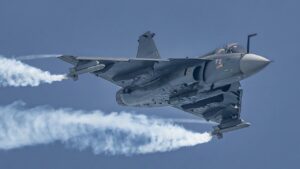
“Taking off is optional, but landing is mandatory”
Some of the airfields (with short runways) and emergency situations (non-availability of full runway length) require an adept short landing.
Aircraft are designed to shorten the landing with features like lift augmentation devices, low landing speeds, good braking systems, reverse thrust, tail chutes, air brakes, etc.
These short landings need special techniques. To land within a short field or a confined area, the pilot needs to have precise, positive control of the rate of descent and airspeed, and fly an approach that clears any obstacles.
Tighter margins mean flying the airplane in a narrower envelope than usual. Speed control and energy management are always important, but become more critical in short-field operations.
SAFETY MARGINS
For short runway operation, the most important factor is the runway length, airplane performance comes next followed by the pilot’s skill and experience. Finally comes environmental conditions like wind, elevation, and temperature.
Landing distance data are published by the manufacturer based on landing weight. Performance charts are prepared in near-perfect conditions with a new airplane and professional test pilots. However, a safety margin is added to it.
It is always wise to add a safety margin depending on the deterioration in aircraft and engine performance due to the aircraft’s age, pilot experience, and prevailing weather conditions and runway conditions.
One has to be especially careful at high altitudes on a hot day. Things get riskier with gusty crosswinds, with an associated “sinkhole” on the final approach.
The point is that margins for error are reduced on short, narrow runways, even if the available length is well within “book” performance. Don’t let the book lull you into a false sense of security when conditions aren’t ideal.
Important Aspects
Airspeed or AOA. Many accidents and incidents are associated with airspeed mismanagement. Relying on Angle-of-attack (AoA) indicators is a safer bet. Unlike stalling airspeed, which can vary substantially with bank angle or increased weight, a properly calibrated AoA indicator will always warn of an imminent stall. AoA indicator can be extremely helpful for short landings.
Obstacles. Obstacles on the approach path reduce the net runway length available. Knowing the size of the obstruction and distance from the runway is very important, especially at night or in marginal weather. Operation of primary or secondary controls that cause a sink should be avoided close to the obstacles.
Steady Approach. For a short landing, a wider pattern or longer downwind is preferable to ensure that the airplane is stable. It eliminates many critical variables that add to the workload. Speed or energy management on the approach path is most critical.
Contingencies. On the approach path, it is important to coordinate attitude and power to maintain a consistent descent rate and speed. While excess speed can result in a longer float, slow speeds can result in operations on the back side of the power curve. If this occurs, even the addition of full power might not be enough to overcome the drag of the high AoA. The AoA needs to be reduced while initiating a go-around.
Landing Spot. A key aspect of short landings is the ability to precisely land the aircraft. Floating beyond the desired touchdown point can result in insufficient remaining runway to stop the plane. However, the flare-out point and technique are equally important. An early or overly aggressive flare can result in stalling over the runway. A late or shallow flare could result in a heavy landing, or bouncing.
Touchdown. If the energy is properly managed, the touchdown occurs at the intended spot. The aim should be to carry out a firm landing rather than a smooth one. A firm landing is not a hard landing, but it helps in dissipating the energy.
Braking. The braking technique is to be utilised as stipulated in the aircraft manual. Incorrect braking could result in a runway overshoot or tyre burst/deflation.
Bottom Line
It is critical to follow the Standard Operating Procedure.
Suggestions and value additions are most welcome
For regular updates, please register here
Subscribe
References and credits
To all the online sites and channels.
Disclaimer:
Information and data included in the blog are for educational & non-commercial purposes only and have been carefully adapted, excerpted, or edited from sources deemed reliable and accurate. All copyrighted material belongs to respective owners and is provided only for purposes of wider dissemination.



